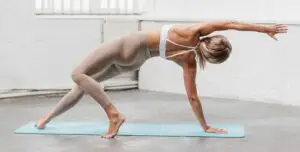If you’ve been practicing Yoga for a while now, you’ve probably heard of Yoga Nidra. However, you may be surprised to hear that Yoga Nidra is not another style of asana but a deep relaxation practice packed with tons of amazing benefits. What’s more, it’s not an advanced practice by any means; in fact, it’s just as popular among yogis and non-yogis.
Yoga Nidra is a guided relaxation practice that takes you into deep states of consciousness between wakefulness and sleep. The method draws your attention inward, similar to meditation, but is performed in a savasana (reclined) position and is accessible to everyone.
Suppose you’re not one for a sweaty Ashtanga class, or maybe you need to balance out your active lifestyle with something more yin. Either way, you’ll be itching to know more about this practice, so let’s dive in.
Where does Yoga Nidra come from?
Yoga Nidra, also known as “yogic sleep,” is an ancient practice with roots in India. It was first mentioned in the oldest yogic texts, the Upanishads (5th century BC) and the Mahabharata (4th century BC). However, there is no description of the method other than being loosely described as deep spiritual sleep.
Historical usage
It was not until the 11th and 12th centuries that we learned more about this mystical practice. Yoga Nidra is mentioned in Buddhist texts, such as in the Mahāmāyātantra, which describes it as “peace beyond words.”
Around the same time, it is mentioned in Hatha Yoga and Raja yoga texts where it is linked to the eighth limb of Yoga, samadhi. Here it is defined as a deep meditative state of consciousness where the practitioner is without thought, movement, and breath.
Modern-day use
Over the following centuries, more and more was revealed about Yoga Nidra through yogic texts. However, it was not until the mid 20th-century that the practice was popularised by Satyananda Saraswati, who claimed to have practiced yoga Nidra with his guru Sivananda Saraswati in Rishikesh.
The version of Yoga Nidra that Satyananda Saraswati adapted into modern-day use differs significantly from the one mentioned in the ancient texts. For example, he removed the use of Sanskrit mantras so that he could share the practice worldwide.
‘Yoga Nidra is a state between sleep and Samadhi. It is a half-sleep and half-waking state: it is not a waking state, and it is not really a sleep state. Yoga Nidra is a state of conscious sleep in which one can record what is going on.’
Swami Rama (1998)
Benefits of Yoga Nidra
If you live a fast-paced lifestyle like most of us, the ancient practice of Yoga Nidra is your antidote. However, the benefits extend much further than experiencing a moment of calm.
Promotes better sleep and reduces insomnia

One of the biggest reasons people turn to Yoga Nidra is because they experience sleep disturbances or insomnia. If that’s what has brought you to this article today, you’ll be pleased to hear that one of the top benefits of the practice is improved sleep quality.
Many people’s minds become active when they get into bed, making it difficult to relax enough to fall asleep at a reasonable hour. Because it induces a sleep-like state, the best time to practice Yoga Nidra is just before bed, and doing so will help you drift off to sleep peacefully.
The method brings your body and mind into a deep state of relaxation, making you less likely to wake up multiple times in the night. However, while this spiritual practice is linked to sleep, you should never replace sleep with Yoga Nidra. It will help you sleep better, but you still need your eight hours every night!
Releases stress and tension
Yoga Nidra is an effective way to regulate your emotions and release both physical and mental stress. This is due to the effect it has on the nervous system. Stress increases activity in the sympathetic nervous system, also known as the ‘fight-or-flight mode, which sends your body out of homeostasis.
The practice of Yoga Nidra rebalances the nervous system and lowers elevated cortisol levels, too. It doesn’t just help on a mental level, either. Stress often manifests in your body as tension and pain. So when Yoga Nidra helps your stress melt away, you’ll notice that any physical pain you were experiencing also vanishes.
What’s more, it’s not only short-term stress that Nidra reduces. Yoga Nidra is also an approved treatment for chronic stress and PTSD (post-traumatic stress disorder). It treats chronic pain by bringing the nervous system into the ‘rest and digest mode’ that promotes healing, stimulates the immune response, and reduces inflammation.
Reduces anxiety
A busy mind is an anxious one. You may have noticed that whenever you’re feeling particularly worried about something, your mind continuously jumps from one anxious thought to another without any breaks. This can be difficult to break out of, but a Yoga Nidra is one practice that allows you to.
Yoga Nidra induces a natural resting state, which allows you to detach from your thoughts. As you turn your attention away from your mind, you realize that your thoughts come and go and do not need a reaction.
Interestingly, a 2018 study that observed the effects of Yoga Nidra compared to seated meditation found that Yoga Nidra was more effective at reducing the physiological symptoms of anxiety. One potential reason is that it’s easier for an anxious mind to follow the guided instructions of Yoga Nidra than to maintain focus on the breath in seated meditation.
Enhances cognitive performance

Aside from its various mental health benefits, Yoga Nidra is good for your brain’s functioning and memory. As the practice creates more space in your mind by clearing your thoughts, you might find your focus and creativity improve. Therefore, Yoga Nidra is an excellent tool to use before studying, taking an exam, or performing a difficult work task.
The combined phases of Nidra also train your brain, which improves your memory and prevents cognitive decline as you age. So you could say that Yoga Nidra keeps you young!
Like with all other benefits, the more you practice Yoga Nidra, the more you will notice your mental performance improve. So aim to follow a guided Yoga Nidra at least once a week, preferably more.
How many phases are there in Yoga Nidra?
Now that you know how Yoga Nidra can benefit you, you probably wonder what it entails. When Satyananda Saraswati adapted the ancient practice into its modern form, he created eight stages that must be followed in a specific sequence for maximum effectiveness.
There are eight phases of Yoga Nidra practice:
- Internalization – This first stage is about settling into the practice by relaxing your body and turning your attention inwards. You’ll be prompted to get into a comfortable position, become aware of any sensations or tension, then turn your attention to your breath.
- Set a Sankalpa – A Sankalpa is an intention that you set for your Yoga Nidra practice, just like you may do with an asana practice. It can be a general feeling or quality you want to cultivate that day or a specific goal you have. Setting a Sankalpa can help train your mind, stay focused, and bring more purpose and direction into the practice.
- Rotation of consciousness – This stage is a body scan where you move your awareness around your entire body, moving from one body part to another. Because you have to focus on following the teacher’s guidance, this stage is excellent at settling an overactive mind and shifting to internal awareness.
- Breath awareness – The body scan helps to prepare you for the fourth stage, breath awareness. This stage involves counting each breath backward to promote deeper relaxation. You breathe normally while counting down each inhale and exhale until you arrive at one. For example, 18 inhaling – 18 exhaling, 17 inhaling – 17 exhaling, and so on, until you reach one.
- Opposites – This stage involves experiencing opposite feelings and sensations in your body. Two common examples would be hot and cold and heavy and light. Shifting between opposite feelings like this harmonizes the brain’s two hemispheres and stops your mind from wandering.
- Visualization – In the sixth stage, you’ll envision specific images or scenarios to remove any mental disturbances. This stage can differ; the teacher may list a series of objects or sights, and you bring to mind each thing. Or you may be asked to visualize yourself in a scenario with much more detail.
- Revisit Sankalpa – Before finishing the practice, you briefly return to your initial intention. The facilitator may tell you to repeat your Sankalpa three times in your mind.
- Externalization – Because Yoga Nidra takes you into profound states of consciousness, it’s essential to take some time to come out of it. In the externalization stage, you’ll bring your awareness back to your breath, the body, and finally, the external environment to slowly reawaken.
Out of all eight stages, four are essential and should be included in any Yoga Nidra Practice. These are initial internalization (settling), the rotation of consciousness (body scan), breath awareness, and the externalization stage.
Setting and revisiting your Sankalpa (intention) is not essential, nor are the opposites and visualisation stages. A Yoga Nidra with all eight steps will last for approximately 45 minutes. Still, by omitting the non-essential phases, you can create a shortened 20-30 minutes practice that does not lose any core benefits.
Can you do Yoga Nidra by yourself?
One reason why Yoga Nidra is different from meditation is that it is challenging to do by yourself without following the guidance of a teacher or facilitator. After some experience with seated meditation, it is not necessary to have instruction to focus your attention on your breath.
However, because Yoga Nidra has various phases that should be followed in a particular order, it requires a lot of mental focus to guide yourself through it correctly. What’s more, you should also remember that the purpose of yoga Nidra is to follow the instructions given, for example, moving your awareness from one body part to another.
Trying to do Yoga Nidra yourself makes it difficult to let go and relax, hindering the benefits you will receive. This remains the case no matter how much experience you have. As a qualified Yoga Nidra facilitator, I have tried to do Yoga Nidra by myself. But, let me tell you, it’s nowhere near as good as listening to a recording.
Although you cannot do Yoga Nidra by yourself, it is still safe to practice it in the comfort of your own home. You will find many great Yoga Nidra recordings on Youtube and Meditation apps.
This 30-minute Nidra practice by Ally Boothroyd is one of my go-to’s as it features all eight steps. However, you can find recordings as short as 10 minutes if time is limited. Alternatively, you can download a Nidra script and get a friend or partner to read it aloud as you follow along.
Many people do Yoga Nidra as a standalone exercise to prepare them for bed or unwind after a busy day at work. However, you can also incorporate it at the end of a workout or asana practice.
Final thoughts
You don’t have to be a dedicated yogi to practice Yoga Nidra. In fact, you can do Nidra even if you have injuries or existing health conditions. There are no predispositions for Nidra, making it accessible, safe, and beneficial for everyone. This is why Yoga Nidra is quickly becoming one of the most popular practices for mental health and general wellbeing. So what’s stopping you from giving it a try?





